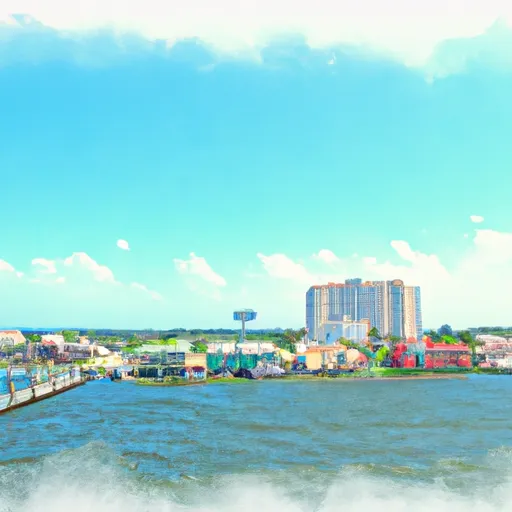-
 Snoflo Premium
Snoflo Premium
Get unlimited access to all our content
With no Ad interruptions! - Start Your Free Trial Login with existing account
Punta-Gorda
Eden Index
Climate
6.5
•
Recreation
4.9
•
Community
1.9
•
Safeguard
4.8/10

Punta Gorda is a charming coastal city located in Charlotte County, Florida. Known for its stunning waterfront views and picturesque landscapes, Punta Gorda experiences a subtropical climate characterized by warm, humid summers and mild, dry winters. The average temperatures range from the mid-70s°F (24°C) in winter to the mid-90s°F (35°C) in summer.
Hydrologically, Punta Gorda is surrounded by various water bodies, including the Peace River, Charlotte Harbor, and the Gulf of Mexico. These waterways offer a diverse ecosystem with abundant marine life, making it a popular destination for fishing, boating, kayaking, and paddleboarding. The area is also rich in estuaries, mangrove forests, and wetlands, providing habitats for a variety of bird species and wildlife.
Outdoor enthusiasts will find plenty of recreational opportunities in Punta Gorda. The city boasts numerous parks, nature preserves, and trails for hiking, biking, and bird watching. Fishermen can enjoy both freshwater and saltwater fishing, while golfers can tee off at the area's golf courses. Additionally, Punta Gorda offers opportunities for sailing, jet skiing, and sunset cruises.
Overall, Punta Gorda's favorable climate, diverse hydrology, and abundance of outdoor recreational activities make it an attractive destination for nature lovers and adventure seekers alike.
What is the Eden Index?
The Snoflo Eden Index serves as a comprehensive rating system for regions, evaluating their desirability through a holistic assessment of climate health, outdoor recreation opportunities, and natural disaster risk, acknowledging the profound impact of these factors on livability and well-being.
Climate Health Indicator (CHI): 6.5
Punta-Gorda receives approximately
1304mm of rain per year,
with humidity levels near 82%
and air temperatures averaging around
23°C.
Punta-Gorda has a plant hardyness factor of
10, meaning
plants and agriculture in this region tend to thrive here all year round.
By considering the ideal temperature range, reliable water supplies, clean air, and stable seasonal rain or snowpacks, the Climate Health Indicator (CHI) underscores the significance of a healthy climate as the foundation for quality living.
A healthy climate is paramount for ensuring a high quality of life and livability in a region, fostering both physical well-being and environmental harmony. This can be characterized by ideal temperatures, reliable access to water supplies, clean air, and consistent seasonal rain or snowpacks.
Weather Forecast
Streamflow Conditions
Peace
Area Rivers
Peace
Snowpack Depths
Peace
Reservoir Storage Capacity
Peace
Groundwater Levels
Recreational Opportunity Index (ROI): 4.9
The Recreational Opportunity Index (ROI) recognizes the value of outdoor recreational options, such as parks, hiking trails, camping sites, and fishing spots, while acknowledging that climate plays a pivotal role in ensuring the comfort and consistency of these experiences.
Access to outdoor recreational opportunities, encompassing activities such as parks, hiking, camping, and fishing, is crucial for overall well-being, and the climate plays a pivotal role in enabling and enhancing these experiences, ensuring that individuals can engage in nature-based activities comfortably and consistently.
Camping Areas
| Campground | Campsites | Reservations | Toilets | Showers | Elevation |
|---|---|---|---|---|---|
| Alafia River State Park | None | 117 ft | |||
| Lithia Springs | None | 51 ft | |||
| Saddle Creek County Park | None | 111 ft | |||
| Withlacoochee River Park | 10 | 94 ft | |||
| Hillsborough River State Park | None | 58 ft | |||
| Edward Medard | None | 79 ft |
Catastrophe Safeguard Index (CSI):
The Catastrophe Safeguard Index (CSI) recognizes that natural disaster risk, encompassing floods, fires, hurricanes, and tornadoes, can drastically affect safety and the overall appeal of an area.
The level of natural disaster risk in a region significantly affects safety and the overall livability, with climate change amplifying these risks by potentially increasing the frequency and intensity of events like floods, fires, hurricanes, and tornadoes, thereby posing substantial challenges to community resilience and well-being.
Community Resilience Indicator (CRI): 1.9
The Community Resilience Indicator (CRI) recognizes that education, healthcare, and socioeconomics are crucial to the well-being of a region. The CRI acknowledges the profound impact of these elements on residents' overall quality of life. By evaluating educational resources, healthcare accessibility, and economic inclusivity, the index captures the essential aspects that contribute to a thriving community, fostering resident satisfaction, equity, and social cohesion.

